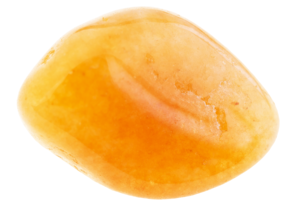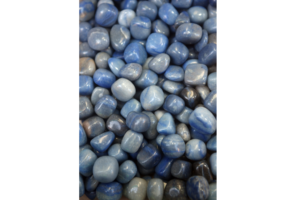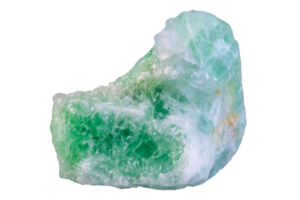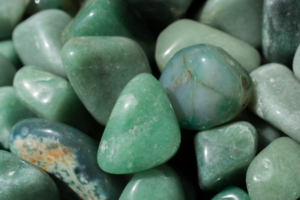What is aventurine?
Aventurine is a mineral that belongs to the quartz family. It is characterized by its shimmering or glittery appearance, caused by the presence of small, reflective particles within the quartz crystal. Aventurine is a popular gemstone and is often used in jewelry-making and decorative objects. It can come in a range of colors, with green being the most common, and is believed to have various metaphysical properties, including promoting emotional balance, enhancing creativity, and boosting abundance and prosperity.
The shapes of aventurine
Aventurine is a mineral that can form in a variety of shapes, depending on the conditions in which it was formed. Here are some of the common shapes aventurine can take:
- Tumbled Stones: Aventurine is often tumbled into small, smooth stones that can be used for decoration or carried as a talisman.
- Cabochons: Aventurine is often cut into smooth, rounded cabochons for use in jewelry.
- Spheres: Aventurine can be shaped into round spheres, which are often used in meditation and energy healing practices.
- Points: Aventurine can be shaped into pointed crystals, which are often used in crystal grids and energy healing practices.
- Hearts: Aventurine can also be carved into heart shapes, which are often used in jewelry or as decorative objects.
The shape of aventurine can affect how it is used and its perceived energy properties. Some people believe that the shape of a crystal can affect its energy flow and the way it interacts with the body.

The colors of aventurine
Aventurine can come in a range of colors, although green is the most common. Here are some of the colors aventurine can come in:
- Green: This is the most common color of aventurine and is caused by microscopic inclusions of green mica or fuchsite within the quartz crystal. The mica inclusions also give aventurine its characteristic shimmer or glitter effect.
- Blue: Blue aventurine contains inclusions of blue dumortierite, giving it a blue color. It is less common than green aventurine.
- Red: Red aventurine contains inclusions of hematite, giving it a red color. It is also less common than green aventurine.
- Yellow and Brown: Yellow and brown aventurine can contain inclusions of goethite or pyrite, which give them their yellow or brown colors.
The intensity of the color and the amount of shimmer can vary depending on the location and conditions in which the aventurine was formed.
What does each color symbolize?
In some belief systems, different colors of aventurine are thought to have different meanings and properties. Here are some common associations:
- Green Aventurine: This is the most common color of aventurine and is associated with abundance, growth, and vitality. It is said to promote emotional balance, reduce stress, and attract good luck.
- Blue Aventurine: Blue aventurine is believed to promote self-expression, communication, and clarity of thought. It is said to help with decision making, especially when it comes to spiritual matters.
- Red Aventurine: Red aventurine is associated with passion, courage, and vitality. It is believed to help with physical strength, stamina, and overall well-being.
- Yellow Aventurine: Yellow aventurine is associated with creativity, confidence, and self-esteem. It is said to promote a positive outlook on life and help with decision making.
The chakra for each color
In some belief systems, each color of aventurine is associated with a specific chakra, or energy center, in the body. Here are the chakras commonly associated with each color of aventurine:
- Green Aventurine: The green color of aventurine is often associated with the heart chakra. The heart chakra is located in the center of the chest and is associated with love, compassion, and emotional balance.
- Blue Aventurine: Blue aventurine is sometimes associated with the throat chakra. The throat chakra is located in the throat and is associated with communication, self-expression, and creativity.
- Red Aventurine: Red aventurine is sometimes associated with the root chakra. The root chakra is located at the base of the spine and is associated with grounding, stability, and physical vitality.
- Yellow Aventurine: Yellow aventurine is sometimes associated with the solar plexus chakra. The solar plexus chakra is located in the abdomen and is associated with personal power, self-esteem, and confidence.
Aventurine’s History

The history of aventurine dates back thousands of years. It was first discovered in India, where it was used for ornamental and decorative purposes. The name “aventurine” comes from the Italian word “avventurina,” which means “by chance.” The name refers to the accidental discovery of aventurine glass, a type of glass that contains small metallic inclusions that give it a sparkly appearance similar to aventurine.
In ancient Tibet, aventurine was believed to promote peace and healing, and was used in traditional medicine practices. The ancient Greeks and Romans also valued aventurine for its beauty and believed it had healing properties.
During the Middle Ages, aventurine was used in alchemy and was thought to have magical properties. It was also used in religious art and decoration, particularly in churches and cathedrals.
In the modern era, aventurine continues to be valued for its beauty and is often used in jewelry and decorative objects. It is also used in alternative healing practices and is believed to promote emotional balance, prosperity, and creativity.
Overall, aventurine has a rich and diverse history, and has been valued for its beauty and perceived healing properties for thousands of years. It has been used in art, medicine, religion, and culture, and its popularity continues to this day.
 Metaphysical Properties
Metaphysical Properties
Aventurine is a mineral that is believed to have various metaphysical properties, and is often used in alternative healing practices. Here are some common beliefs about what aventurine helps with:
- Emotional Balance: Aventurine is believed to promote emotional balance and stability. It is said to help calm the mind, reduce anxiety, and promote feelings of peace and tranquility.
- Creativity: Aventurine is believed to enhance creativity and imagination. It is said to help stimulate new ideas and promote inspiration.
- Abundance and Prosperity: Aventurine is often associated with abundance and prosperity. It is said to attract good luck, wealth, and success.
- Physical Health: Aventurine is believed to have healing properties that promote physical health and well-being. It is said to help with circulation, improve overall vitality, and boost the immune system.
- Relationships: Aventurine is said to promote positive relationships and attract love and friendship. It is believed to help heal emotional wounds, promote forgiveness, and increase empathy and understanding.
Activating the Energy
There are several ways to activate the energy of aventurine:
- Meditate with Aventurine: Holding or placing aventurine on the body during meditation can help activate its energy. Close your eyes, take deep breaths, and visualize the energy of the crystal flowing through your body.
- Wear Aventurine Jewelry: Wearing aventurine jewelry, such as a necklace, bracelet, or earrings, can help activate the energy of the crystal throughout the day.
- Carry Aventurine with You: Carrying a piece of aventurine in your pocket or purse can help keep its energy close to you throughout the day.
- Place Aventurine in Your Environment: Placing aventurine in your environment, such as on your desk or in your bedroom, can help activate its energy and promote a positive and peaceful atmosphere.
 Cleansing your Aventurine
Cleansing your Aventurine
Here are some common methods for cleansing aventurine:
- Running Water: Holding aventurine under running water for a few minutes can help cleanse it. Use cool or room temperature water, as hot water can damage some crystals.
- Salt Water: You can also cleanse aventurine by soaking it in salt water for a few hours. Use purified or spring water and add a tablespoon of sea salt or Himalayan salt to the water.
- Smoke: Burning sage or other cleansing herbs and passing the aventurine through the smoke can help clear its energy.
- Other Crystals: Placing aventurine on a bed of other cleansing crystals, such as clear quartz or amethyst, can help cleanse its energy.
It’s important to note that some methods of cleansing may be more suitable for certain types of aventurine or other crystals, so it’s important to research the best cleansing methods for the specific type of crystal you have. Additionally, always make sure to cleanse and charge your aventurine regularly to maintain its energy and benefits.
Summary
Aventurine is a mineral that belongs to the quartz family and is characterized by its shimmering or glittery appearance. It can come in a range of colors, including green, blue, red, yellow, and brown. Different colors of aventurine are associated with different metaphysical properties and are sometimes linked to specific chakras in the body.
Aventurine is believed to have various healing properties, including promoting emotional balance, enhancing creativity, boosting abundance and prosperity, and improving physical health. To activate the energy of aventurine, it can be meditated with, worn as jewelry, carried, or placed in the environment.
It’s important to regularly cleanse aventurine to clear any negative or stagnant energy it may have absorbed. Common methods for cleansing aventurine include running water, salt water, smoke, and other crystals. By cleansing and charging aventurine regularly, its energy can be maintained, and its benefits can be enhanced.

